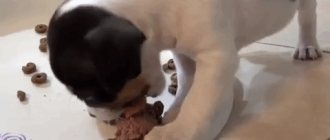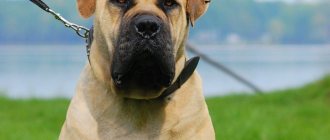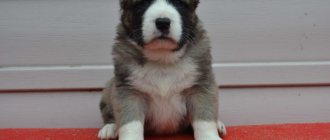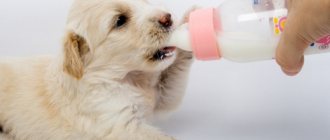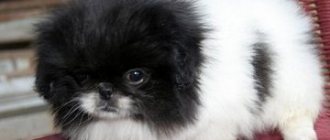Shar Peis were recently considered a rare breed, but demand creates supply. Now many breeders breed these dogs, and the demand for them is quite high. Taking a dog home is a very responsible act. It would be good to first learn more about the representatives of the breed that you have chosen, so that all its features do not come as a surprise to you, and you do not regret your purchase.
Shar Pei - breed features
Shar Pei is an ancient fighting dog breed. It’s hard to believe, but a dog’s cute folds are armor that protects a fighter’s body from serious wounds. In addition to the unexpectedly sharp character, there are other characteristics of the breed that it is better for the potential owner to know about in advance.
Unfortunately, almost all Shar Peis become regular patients in veterinary clinics. Due to constant illnesses, hereditary diseases often develop.
The breed is characterized by: food and atopic allergies, dermatitis of various etiologies, problems with the eyes and ears, chronic inflammatory processes of the mucous membranes and conjunctivitis. Most problems do not appear or appear in a less severe form if the dog eats properly from puppyhood.
Pro Plan
Pro Plan is one of the most popular premium feeds in Russia . It is distinguished by a wide range and focus. You can choose food for a dog of any size and any age, with different health characteristics.
You can also choose almost any flavor for your pet - lamb, beef, salmon, chicken, and the same flavors, but with rice.
This food belongs to the premium class; only veterinary diets from this manufacturer can count on a higher level.
Pros of food:
- Supports healthy teeth and gums, contains vitamin D, calcium and phosphorus;
- Positively affects the condition of the joints - the correct ratio of proteins and omega3;
- Contains prebiotics and has a beneficial effect on digestion and the microflora of the intestines and stomach.
Cons of food:
- Very little protein, but a lot of carbohydrates;
- The composition is not clearly stated;
- Contains insufficient amounts of vitamins;
- It contains gluten, wheat and corn - cheap fillers and not the healthiest sources of protein.
Choosing a place and utensils for feeding
Until the Shar Pei puppy reaches 7–9 months of age, the owner needs to make every effort to care for the pet. The choice of place and utensils for feeding plays an important role in a comprehensive approach to caring for your dog.
Shar Peis eat a lot even as children. Puppies eat extremely sloppily, so it is better to choose wide and deep bowls. Be sure to purchase a bowl stand whose height can be adjusted as your dog grows. Without a stand, your Shar Pei puppy will regularly suffer from hiccups and get more dirty when eating.
Historical summary
It is believed that Shar Pei originated in Ancient Asia sometime around 200 BC. Translated from Chinese, this dog breed means “special wool.” Their fur is rough to the touch.
The appearance of Shar-Peis is unusual. However, this did not prevent their wide distribution. They served as guard and fighting dogs, as they showed the character of a protector. In the 20th century, representatives of the breed were on the verge of extinction.
Important! Shar Peis were declared a rare breed because during the Cultural Revolution, the Chinese ate dogs for lack of other food.
We must thank the activists for saving these animals, who collected the last representatives of this extraordinary breed and took them to Hong Kong and Taiwan. There, caring people started breeding them.
What to feed a Shar Pei puppy - choosing the type of diet
When choosing what to feed your Shar Pei puppy, take seriously all the pros and cons of food types. If the Shar Pei puppy is your first dog, be sure to consult with your veterinarian about diet and care options.
- Natural feeding.
- Industrial feeding.
- Mixed feeding.
All three types of nutrition have pros and cons. It is important to understand that there is no ideal food option for a Shar Pei puppy, since the process of selecting a diet will necessarily reveal the individual characteristics of your pet.
Natural diet
A natural diet is considered the best, but not ideal, choice for a Shar Pei puppy. Natural food helps protect your pet from dysbiosis, to which all representatives of the breed are prone. However, when choosing natural products, there is a high probability of food allergies.
A natural diet for a Shar Pei puppy includes:
- Feeding raw and cooked foods.
- Feeding meat porridge.
- Feeding exclusively raw foods is a raw food diet.
Advantages:
- By the age of 3–4 years, almost all shapres begin to have problems with the gastrointestinal tract due to dysbacteriosis. The problem is contained or stopped with dairy or fermented milk products, which can only be given if the dog is on a natural diet.
- Control of the quality, freshness and composition of dog food.
- The ability to guarantee the exclusion of allergens if they are identified.
- A natural diet is cheaper.
Flaws:
- You need to spend time preparing food for your dog.
- You need to buy only high-quality, natural products and prepare homemade fermented milk products.
- Natural food spoils quickly.
- In case of allergies and the inability to identify the allergen, a natural diet is unacceptable.
A Shar Pei puppy can be switched to a natural diet at the age of 1 month. Until 2–3 months, the baby will still consume mother's milk, which is necessary for normal growth and formation.
Important! All new foods should be introduced into the puppy’s diet carefully, in small quantities.
Ready-made feed
Ready-made food has several significant advantages, but the main one is the ability to feed your dog hypoallergenic food. Experience shows that a Shar Pei puppy can develop an allergy to proteins or gluten. High-quality industrial feeds do not contain gluten. Industrial feeds contain semi-processed proteins that release less allergen during digestion.
Because Shar Pei puppies often bite their cheeks while chewing, they should not be fed only solid foods. Eating only soft foods will lead to gum problems.
If you decide to feed your Shar Pei puppy with ready-made food, you should alternate the following types:
- Dry (granules).
- Semi-moist (pieces with gravy).
- Moist (pate or paste).
- Treats.
The key factor in choosing food is its quality or grade. The higher the grade of food, the higher the chance that it is made from good products. High-quality feed contains essential vitamins and minerals. However, the higher the quality of the feed, the higher its cost.
Industrial feeds are divided into classes:
- Economy
- Premium
- Super premium.
- Holistic.
If the dog is absolutely healthy, everyday food is suitable for it. Since dogs in good health are rarely found among Shar Peis, it is better to choose specialized food for your puppy.
According to their intended purpose, ready-made feeds are divided into:
- Supportive.
- Preventive.
- Medicinal.
- For exhausted animals.
- Hygienic (usually treats).
Advantages:
- No need to cook.
- There is no need to constantly give vitamins.
- There are hypoallergenic series.
Disadvantages of ready-made feeds:
- Industrial feed will cost more than natural feeding.
- Expensive food from well-known brands is often counterfeited, and this is fraught with a severe allergic reaction.
Remember! A Shar Pei puppy can be fed high-quality pates from the age of one month. Pieces of food can be given to your baby from 3-4 months of age. Switching to dry food is not recommended until the teeth have completely changed.
Mixed diet
A mixed diet involves simultaneous feeding of natural products and ready-made food. Given the hereditary tendencies of Shar Peis, a mixed diet is absolutely unacceptable. Perhaps you have seen shaprees that look sickly, with sour and puffy eyes, a swollen face, whitish or green nasal discharge, or perhaps the dog smells very bad? These are just some of the consequences of a mixed diet.
Industrial feed
Advantages:
- No need to waste time cooking;
- It is stored longer than natural;
- You don’t spend extra money on vitamins;
- Easy to take on the go;
- Sometimes cheaper;
- If you have an allergy, you can simply change the food;
Flaws:
- The ingredients on the package may not match the contents;
- Cheap food causes serious health problems;
- Vitamins in food lose their original usefulness;
- Emulsifiers and preservatives and other additives can cause allergies.
There are several types of artificial food: dry, semi-moist and wet. Each of them also has its own disadvantages and advantages.
For example, dry food does not spoil for a long time . It doesn't stain the bowl or the area around it and even helps remove plaque from your teeth. But at the same time, flavorings and flavor enhancers are often added to such food.
Wet food is easier to digest and almost always contains no additives . But at the same time, it is addictive. The best option is to alternate these two types of food.
This way you can diversify your pet’s menu and make its diet more healthy and balanced.
There are four classes of feed:
- Economy class;
- Premium class;
- Super premium class;
- Holistic.
Each class of food has its own manufacturers and its own lines of food.
IMPORTANT!
Veterinarians advise feeding dogs food of at least premium quality, although this is not always of high quality.
Shar Pei food is produced by the CIBAU brand . All other manufacturers divide their food line by age, size of the dog, and the presence/absence of allergies.
Sample menu by age for a Shar Pei puppy
An approximate menu by age for a Shar Pei puppy will help you understand the future costs of time and money to raise a healthy dog. Let us immediately note that the recommendations below are very general; for a Shar Pei puppy you need to create a narrower, individual diet.
Important! It is not recommended to switch Shar Peis from one type of food to another at any age. This measure is valid only in the case of the development of an allergy, the root cause of which cannot be identified.
Up to a month
It is extremely important that your Shar Pei puppy receives enough mother's milk before the age of one month. Without mother's milk in the first 5 days, the puppy can survive on artificial feeding, but he is guaranteed to have dysbiosis.
If the baby lost the care of his mother at a week of age or older, artificial feeding can trigger the development of allergies. In addition, mother's milk contains antibodies, without which babies are vulnerable to all viruses.
Important! Only high-quality bitch milk substitute is suitable for artificial feeding of a Shar-Pei puppy.
The frequency and volume of food eaten is controlled by the mother dog. If you are artificially feeding a Shar Pei puppy, it is recommended that you give him the opportunity to eat on demand. The standard feeding scheme looks like this:
- From birth to 2 weeks, Shar Pei puppies eat every 2 hours.
- From 2 to 4 weeks of age, Shar Pei puppies eat every 2-3 hours, with a night break of 4-6 hours.
Note! Bitch milk replacer is not as nutritious as the original, so the puppy may ask to eat more often.
At 1 month
At 1 month old, your Shar Pei puppy can be given complementary foods. All new products must be fresh and of high quality.
Natural menu for a Shar Pei puppy aged 1 month:
- Mother's milk.
- Whole goat or cow's milk.
- Low-fat broth.
- Boiled minced meat mixed with broth.
Industrial:
- Bitch milk substitute.
- In case of growth retardation - pate for emaciated puppies.
Serving size depends on growth rate.
Number of feedings (complementary feeding): 5–6 times a day, excluding mother’s milk.
At 2 months
At 2 months, a Shar Pei puppy needs to carefully expand its diet and carefully monitor the reaction of the pet’s body. Each new product is given in an amount of 5–10 grams. Afterwards, you need to wait 2-3 days. During the waiting period, carefully examine your pet for rashes and irritation of the mucous membranes. The slightest negative reaction is a signal to eliminate the product from the diet.
Natural menu:
- Mother's milk.
- Whole cow's or goat's milk.
- Calcined cottage cheese.
- Dairy products.
- Bouillon.
- Boiled minced meat.
- Ground, raw, boiled meat.
Industrial menu:
- Bitch milk substitute.
- Canned food for puppies of medium breeds prone to allergies.
Serving size depends on body weight.
The number of feedings varies from 4 to 6 times a day, excluding mother's milk consumed.
At 3 months
At 3 months, the Shar Pei puppy receives its first vaccinations, after which it moves to a new home. Stress usually causes food allergies, if any. If an allergy appears, there is no need to be alarmed. Try to stick to your puppy's usual feeding schedule and menu. If necessary, the veterinarian will prescribe antihistamines. For 10–14 you just need to wait it out; if the dog is in potentially good health, the allergic reactions will subside.
Natural:
- Mother's milk (if the puppy is still with its mother).
- Whole milk, fermented milk products, cottage cheese.
- Boiled minced meat, raw, chopped meat.
- Broth, vegetable soup with meat broth.
- Raw quail eggs. Chicken eggs: yolk only, boiled or in the form of an omelet.
- Rice, buckwheat.
If the puppy becomes allergic to ready-made food, the product should be changed to hypoallergenic.
Industrial menu:
- Bitch milk substitute.
- Canned food for puppies of medium breeds prone to allergies.
- Semi-moist food for puppies of medium breeds prone to allergies.
Portion sizes for a 3 month old Shar Pei puppy are constantly increasing. Number of feedings for a Shar Pei puppy at the age of 3 months: 4-5 times a day.
At 4–6 months
At the age of 4–6 months, the Shar Pei puppy’s diet gradually expands. You need to make sure that your dog has a clean face after eating. When the puppy starts eating the porridge, fragments may get caught in the folds. If leftover food is not removed immediately after eating, it will cause bacterial skin lesions.
Natural menu:
- Whole milk, fermented milk products, cottage cheese - in large quantities.
- Boiled and raw meat without fat and bones - beef, veal, rabbit, turkey, quail.
- Beef by-products, boiled, chopped. You can use peeled, washed tripe in its raw form.
- Chicken and quail eggs – raw, boiled, omelet.
- Cereals – buckwheat, rice, barley, wheat and barley.
- Vegetables – boiled with porridge, raw with meat or cottage cheese.
Industrial menu:
- Pates for puppies of medium breeds prone to allergies.
- Semi-moist food for puppies of medium breeds prone to allergies.
- Soaked dry food for medium-sized dogs prone to allergies.
The serving size depends on the individual characteristics and taste preferences of the dog.
Number of feedings: 3-4 full meals and 2-3 snacks.
From 6 months to 1 year
At the age of 6 months to 1 year, a Shar Pei puppy develops taste preferences. By the age of six months, if a pet has an allergy, most often it is possible to find out what is causing it. If there is no food allergy, it is better to feed your pet natural food.
Natural menu for a Shar Pei puppy:
- Meat – beef, poultry, rabbit.
- Meat by-products – beef, poultry.
- Milk (unless lactose intolerant).
- Fermented milk products - any, preferably homemade.
- Fish – low-fat, oceanic, peeled, boiled.
- Fish and meat broths.
- Chicken and quail eggs.
- Cereals – buckwheat, rice, barley, wheat and barley.
- Vegetables except boiled potatoes and raw cabbage.
- Fruits, except juicy and very sweet.
- Greens, grass, bran.
Industrial menu:
- Until the complete change of teeth (7–8 months) - wet and semi-moist food for puppies of medium breeds prone to allergies, soaked dry food.
- After a complete change of teeth - 75% dry and 25% wet or semi-moist food for dogs of medium breeds prone to allergies.
The serving size gradually increases, then, from the age of 8–9 months, it decreases. The final serving size is determined individually, depending on the dog’s metabolic rate and lifestyle.
The number of feedings is gradually reduced to 2–3 times.
If your dog has allergies
Not everyone knows what to feed to avoid allergies. If an allergic reaction to food occurs, a number of measures must be taken. First of all, eliminate the product that caused the reaction. Next, the animal is transferred to a rice diet. It is recommended to add olive oil to the serving. Do not allow the presence of food additives in the form of pollen, yeast, etc.
Leave carrots in your diet as a vegetable. After such feeding, which lasts 2 weeks, you can introduce a special anti-allergenic food.
What you can feed a Shar Pei is a special question. The owner decides which food to choose – dry or natural. But you need to remember that the Shar Pei is a dog prone to allergies, and therefore requires a carefully selected menu.
Vitamins and supplements in the diet of a Shar Pei puppy
Vitamins and supplements are given on an ongoing basis at least until the age of one, if the Shar Pei puppy eats natural food. When the dog is one year old, vitamins are given in courses. If the dog eats high-quality industrial food, vitamins and supplements are given only as prescribed by a veterinarian.
Natural vitamin supplements for your Shar Pei puppy:
- Meat and bone meal.
- Clean, dried, crushed egg shells.
- Bran.
- Fish, chicken, beef liver.
- Greens, vegetables, fruits.
- Sunflower oil, olive oil.
- Brewer's yeast.
Pharmacy vitamin supplements for Shar Pei puppy:
- Fish fat.
- Feed tricalcium phosphate.
- Omega-3, Omega-6.
- B vitamins.
- Undevit and analogues.
Some pharmaceutical products are not always appropriate, since a Shar Pei puppy may develop individual intolerance. If any alarming symptoms appear, it is better to transfer the dog to industrial vitamin complexes.
Ready-made food for dachshunds
Speaking of ready-made dry food, buy only super premium food, which contains enough proteins and nutrients for the active temperament of your dachshund. Allergies do not occur very often, but if they do occur, you need to switch to dietary food and give up natural food.
Best food:
- Summit;
- ANF Holistic;
- Guabi Natural;
This food belongs to the super premium class, and some lines are holistic, produced in Canada.
Main ingredients:
- meat;
- oatmeal;
- barley;
- bouillon;
- fish meat;
- vegetables and fruits;
- berries.
The obvious advantages of the food are high quality natural meat, but not more than 30%, complete vitamin complexes. If your dachshund suffers from obesity, then it is better to choose a holistic dog from the Summit line. Because chicken fat and broth are too high in calories.
One example of quality holistic products is American-made ANF Holistic. For a dachshund, the more suitable series is Canine Holistic Duck & Potato Adult Dog, which has the following composition:
- natural meat and meat by-products;
- beet;
- potato;
- amino acids;
- vitamin supplements.
By the way, no chemicals are used in the diet, but vitamins are not presented in the form of fruits or vegetables, but in special additives. Therefore, for a more varied composition, buy Grain Free, but it is dietary.
Farmina – varied food made in Italy and Brazil. There are several food options:
- Fun Dog;
- Ecopet;
- Cibau;
- Vet Diet.
Ingredients:
- meat from 50%;
- potato;
- vegetables;
- fruits;
- berries;
- healing herbs;
- vitamin complexes.
It is very important that the diet contains animal rather than plant protein, which is much healthier and does not contribute to obesity. Also, only natural meat products are used
The Guabi Natural line is manufactured in Brazil, is considered a super premium food, there are different options for medium and large breeds, for active pets and allergy sufferers. Main components:
- several types of fresh meat;
- rosemary;
- healing herbs;
- fish;
- mineral complex.
Remember that when feeding Guabi Natural you do not have to buy additional vitamins or feed fresh meat. Since the food is nutritious, it requires half as much as natural food portions.
Wolfsblut is made in England and is a holistic product. Therefore, the share of meat is large - from 50%, and there are no preservatives or flavorings. For dachshunds, the Dark Forest line is suitable, which includes:
- potato;
- meat;
- vegetables;
- fruits and berries;
- herbs;
- mineral complexes.
It is also convenient that there are lines of wet food that can be given from the third month of life. The composition is rich in natural meat and offal in the form of liver, and vitamins are presented in the form of fruits and berries.
Water in a puppy's diet
For normal growth and development, a Shar Pei puppy needs a lot of water. Skin that forms folds has a loose structure, which implies a large amount of water in the body. In addition, Shar Pei puppies have very sensitive skin and digestive systems, so dehydration is dangerous for them.
Make sure your Shar Pei puppy has constant access to a water bottle. If necessary, place several drinking bowls in areas where the puppy can access at any time. The water in the drinking bowl must be fresh, since standing (especially in hot weather) can become a source of bacteria.
Upbringing
Shar Peis are characterized by a stubborn disposition, so it is important to properly socialize the puppy from an early age. The first commands and correct behavioral manners need to be taught from a young age, as soon as the period of adaptation to the new environment has passed.
Don't encourage "bad" habits. It is almost impossible to wean an adult dog from bad manners.
Video: excavations on the bed
To avoid problems communicating with other animals, teach your puppy to play together with them. Stop aggression towards strangers and animals. If you miss this moment, the adult dog will feel superior, impunity and may get out of control, which will result in serious problems.
Start basic training at 2–3 months. Nurture at an early age will soften dominant character traits. Be persistent, but do not punish disobedience. Harsh physical force is unacceptable. For following commands, reward your dog with treats and approving intonations, this will help develop the necessary reflexes. If classes are held with an instructor, consolidate the acquired skills yourself.
Prohibited Products
It is important to exclude prohibited foods from your Shar Pei puppy’s diet:
- Bones, pure fat, skin, especially poultry.
- Palm oil.
- Grapes, raisins.
- Soy.
- Mushrooms.
- Corn and semolina.
- Raw freshwater fish.
- Dry, salted fish.
- Products containing sugar or sugar substitutes.
- Products containing xylitol (chewing gum, some sweets).
- Products containing flour or yeast.
- Products containing caffeine, cocoa, any stimulants (sweets, tea, coffee, chocolate).
- Products containing marinades, salt, spices.
- Smoked products, including sausages, balyki, fish.
- Expired products.
- Leftovers from the table.
Controversial foods in the diet of a Shar Pei puppy are:
- Lean raw pork.
- Raw ocean fish.
- Whole milk.
- Honey.
- Chicken eggs.
- Raw and boiled chicken liver in large quantities.
If your Shar Pei puppy is allergic, it is better to immediately exclude all controversial foods that contain allergens from the diet.
You should try introducing foods to which individual sensitivity may occur into your diet. If your Shar Pei puppy does not experience diarrhea or other severe reactions, they can be left on the menu permanently.
What not to give to a Shar Pei
Don’t forget that there is a list of things that should not be given even to an adult Shar Pei:
- fatty and fried foods;
- fast food;
- raw sea fish;
- fatty meats like pork, beef;
- natural milk;
- smoked meats and pickles;
- sweets;
- flour and pasta products.
Remember that you should not give your dog walnuts, long bones or poultry skins. These foods are indigestible and cause diarrhea.
Whatever the Shar Pei’s diet, it is important to adhere to the portion and feeding regimen, give food at the same time, and monitor the amount of vitamins and fats. Then the pet will be healthy, active and without health problems
Characteristics
Shar Peis are often referred to as "teddies". They give the impression of a “rounded teddy bear.” The coat is short. The color is one-color. To date, seventeen types of colors have been officially registered. Shar Peis have a massive head and a body covered with large folds. On their head, a very beautiful “hieroglyph” is laid out from the folds, which attracts potential owners. The ears stick out and droop forward.
The tongue is dark blue, the tail is raised high, slightly curled. Calm, serious, reserved dog, friendly and active.
Wary of strangers. They are unfriendly with strangers and are restrained in expressing their feelings. Most representatives of this breed, although independent, are devoted to their owners, love and protect their home. Shar Peis are very clean, unobtrusive and leisurely. By nature they are “philosophers”. To carry out the command, they must be given time to think. For socialization, a puppy needs training and education. Very smart.
Acana Adult Dog Heritag 17 kg
Holistic class food without grains, allergic substances. Contains different types of meat, fish - 55%. It contains eggs, medicinal herbs, vegetables, fruits, fermentation products, vitamin and mineral supplements. Does not contain GMOs.
pros
- Suitable for any dogs;
- It has useful composition and properties;
- Natural ingredients;
- Rich in fiber;
- Has good taste;
- Has a low glycemic index;
- Economical.
- When eating, there are no problems with the skin, vision, joints, or gastrointestinal tract.
Minuses
- Sold in large packages;
- Not all stores have it.
- Contains legumes, which increases gas formation.
Development from 1 to 12 months
| Age | Weight, kg | Height at withers, cm |
| 1 month | 3-3,5 | 21-23 |
| 2 months | 5-8 | 29-30 |
| 3 months | 8-10 | 33-35 |
| 4 months | 11-14 | 35-38 |
| 5 months | 15-17 | 38-39 |
| 6 months | 18-19 | 39-41 |
| 7 months | 19-21 | 41-44 |
| 8 months | 19-22 | 44-47 |
| 9 months | 22-24 | 47-48 |
| 10 months | Approximately 25 | 48-51 |
Data on the height and weight of puppies are averaged and minor discrepancies with them are not a cause for concern .
However, if the puppy’s body weight is significantly higher than average, it is important to make sure that he does not have developmental disabilities or obesity - Shar Pei are prone to overeating and gaining excess weight.
The length of the body should be almost equal to the height of the puppy at the withers.
How to measure the required weight
It’s definitely not possible to measure dry food without a scale. Therefore, if you want to know the perfectly accurate amount of feed, you will have to purchase a kitchen scale.
Manufacturers of some expensive foods include special measuring cups in the pack, with which you can pour the desired portion. However, it is worth remembering that such a container is designed only for this brand, because all dry products have granules of different densities, sizes and weights.
If you count only approximately, the food can be poured into a 100 ml cup - it will be about 240-250 grams. When buying food in bulk, you can ask the seller to divide the product into several parts equal to the daily feeding rate. And at home you can simply divide them in half: for breakfast and dinner.
When can a combination be allowed?
Veterinarians say that mixed nutrition is inadmissible, since when digesting dry food and natural food, the animal’s intestines function differently.
However, there are times when a mixed diet cannot be avoided, and there may be different situations among them.
Feeding puppies in the nursery. Breeders deliberately add fermented milk products, cottage cheese, vegetables or herbs to dry food so that the animal can easily adapt to any type of nutrition in the future, because it is not yet known what scheme the future owner will choose for the pet.
Keeping a puppy dog or stud dog. This category of animals requires food with a high concentration of nutrients; as a rule, the basis of the diet is the dog’s usual food (natural or granules), but an alternative option is added to it.
- Large breeds of dogs - hunting, working, sporting. For this group of animals, you should select a menu that contains an increased (by about 30% compared to the standard) amount of protein. If a dog receives dry food, then the only way to increase the protein in its diet is to additionally feed it with meat, eggs, and cottage cheese.
- Dogs are picky eaters. As a rule, picky eaters eat only meat from natural foods, leaving behind vegetables and cereals. However, with such a diet, very soon they will develop a deficiency of carbohydrates, fiber and vitamins in the body. And protein without vegetables will not be fully absorbed. This is where dry food comes to the owner’s aid. If your pet refuses pellets, you can try giving him wet food.
- Encouraging your pet. There are special reward treats for training an animal. However, if they are not available, it is convenient to take dry granules for a walk, using them as encouragement when teaching commands. In other cases, on the contrary, a piece of meat, favorite vegetables or fruits can be a way to pamper a pet on a dry diet.
- Travel, vacation. These are cases of forced mixing of feeding types. On the road, it is usually not possible to feed the animal natural food, so the owner temporarily switches the pet to dry granules. However, you can’t just take ready-made food on the road and offer it to the animal; the transition should be smooth and begin 3-5 days before the trip.
In these cases, it is allowed to combine different types of food, but it is better to alternate them and not give different types of food at one time. We must not forget that dry granules are moistened with the animal’s saliva before they enter the stomach and begin to be digested. If you give the granules along with natural food, for example, porridge, then there will not be enough saliva to soak the granules, which can cause digestive problems in the animal.
Royal Canin medium adult 15 kg
Super premium food, created for a dog’s balanced nutrition and all its taste needs. Its composition: cereal flour, dehydrated pork, rice, fats of vegetable and animal origin, yeast. A vitamin and mineral complex has been added to the product.
pros
- Widely distributed throughout the Russian Federation;
- Has good taste;
- Well digested by the body;
- When consumed, the immune system is strengthened and the appearance of the skin and coat improves;
- The product has medicinal properties.
Minuses
- Contains grains;
- Lots of crafts. The original is made in France.
Compound
Veterinarians advise choosing a mixture with 20-25% proteins for sedentary representatives of the breed. Animal protein prevents the development of obesity and supports muscle growth.
The Shar Pei's daily diet should include the following components:
- Meat (duck, beef, turkey, rabbit);
- Cereals;
- Vegetables and plant fibers;
- Natural preservatives (tocopherol, ascorbic acid).
Dry food is the basis of the Shar Pei diet. With careful selection of food products, it is impossible to achieve a balance of proteins, fats, carbohydrates, vitamins and minerals. But ready-made food contains a full complex of substances in digestible form.
Main diseases and what food can help cope with them
If you want to avoid a number of diseases that are inherent in Shar Pei, it is better to use professional food:
- dysplasia and arthritis – Josera, Brit;
- renal failure – Canidae;
- skin infections – Royal Canin Skin Care SK;
- allergies – Innova, Royal Canin;
- bloating, flatulence and digestive tract problems - Eagle Pack Holistic Select, Orijen.
Remember that some diseases require treatment not only with a special diet, but also with vitamins, ointments and medications prescribed by a veterinarian.
Vaccination schedule
After the bitch's lactation period ends, the puppies gradually lose the protection they received from their mother's milk.
To develop their own immunity capable of resisting plague, hepatitis, adenovirus, parainfluenza, leptospirosis, parvo- and coronavirus enteritis and rabies, they need vaccination.
| Vaccination scheme | |
| Scheme 1 |
|
| Scheme 2 |
|
Only an absolutely healthy puppy is allowed to be vaccinated, which must be dewormed 10-14 days before vaccination..




